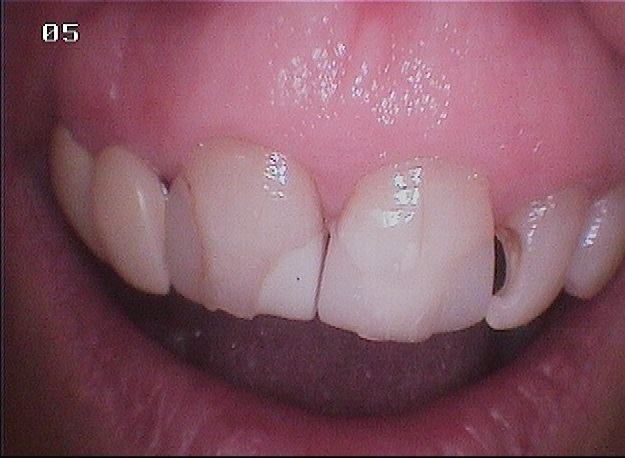Aesthetic dentistry
Whitening
Many people, both young and old, are interested in having a “Hollywood smile”. The most popular and simplest procedure in modern dentistry for improving the aesthetic appearance of teeth is the teeth whitening procedure. There are various possibilities of improving the colour of teeth, whether during professional whitening in the office or using a tray with whitening gel for self-application at home.
Although the cosmetic whitening procedure is quite popular, not many patients opt for it, due to false myths circulating around the procedure.
However, many studies confirm that teeth whitening is safe and effective. A moderate to significant change in colour can be observed in almost every patient who decides to undergo teeth whitening. It should be remembered, however, that teeth whitening is not a permanent solution and requires “refreshing” and the use of appropriate toothpastes to maintain the effect.
Discolouration of teeth
The natural colour of a tooth ranges from white through shades of grey-blue to ivory. Tooth discolouration can be caused by external factors that create deposits on the tooth surface as a result of the deposition of pigments from dark drinks, food and tobacco. This discolouration can affect both enamel and dentin. Superficial deposits on the enamel are usually removed by brushing or preventive cleaning in the office, while the deeper deposits located in the dentin can only be removed by whitening.
Discolouration caused by intrinsic factors may be caused by, among others, drugs (tetracyclines administered during tooth formation, fluorosis, materials used in the past for root canal treatment, chemical disorders during the maturation of enamel and metabolic diseases) and trauma.
Before we take steps to improve the aesthetic appearance of teeth, it is necessary to correctly diagnose the cause of discolouration and to select an appropriate whitening method for live and dead teeth.
The intensity of the discolouration depends on:
- Degree of tissue calcification dentine mainly
- Age - with age, as a result of enamel abrasion, pigments are deposited in the deeper layers of the tooth. It is normal for the teeth to become darker in older people as the enamel becomes thinner, more translucent and the yellow dentin under the enamel begins to show through.
- Genetic traits
- Eating habits: Red wine, coffee, tea, cola, carrots, beets, berries and many other coloured drinks and foods cause stains to build up. In addition, the consumption of acidic products - citrus fruits and juices contribute to the erosion of enamel.
- Smoking: brown pigments from cigarette smoke are gradually absorbed into the tooth structure causing discolouration.
- Medicines and chemicals: Tetracyclines taken by pregnant women and children under 7 years of age can cause dark grey or brown spots that are very difficult to remove. Excessive intake of fluoride during the formation of the enamel of permanent teeth causes fluorosis, which is characterised by white-brown stains.
- Bruxism - Gnashing of teeth can lead to micro-cracks and to the darkening of incisal edges due to the exposure of dentin.
Whitening effect
The maximum teeth whitening effect that can be achieved is predictable and we discuss this thoroughly with the patient prior to the procedure. In order to avoid unnecessary disappointment on the part of the patient, he or she should be informed that we will never achieve the “tile white” effect and that the final colour after whitening is individually variable. However, many patients are satisfied with the result they obtain.
"Two sides of the coin" - What can be the side effects of whitening?
-
The most common are:
- No or insufficient whitening effect on teeth;
- Excessive translucency of the teeth and their bluish tinge;
- Tooth hypersensitivity - the occurrence of this symptom can be reduced to a minimum by applying a special soothing gel;
- Irritation/burning of the gums - caused by a wrong application of the preparation or its too high concentration or leaking of the trays - in the case of home whitening with individually made trays.
Teeth hypersensitivity after whitening
Dentine hypersensitivity usually manifests itself as severe pain, caused by harmless thermal stimuli such as heat and cold, taste – acidic products, or touch – e.g. during tooth brushing. It may affect individual teeth or their entire group.
The phenomenon of hypersensitivity very often occurs after teeth whitening. However, the degree of intensity is individually variable
and may range from discreet discomfort to strong sensations.
Usually hypersensitivity does not occur during the procedure itself, but if it does, the whitening procedure should be stopped. Most often, however, it appears only after a few hours and lasts no longer than 1-2 days. In order to reduce hypersensitivity after whitening appropriate preparations are applied, which can reduce hypersensitivity to a minimum.
In case of overlay whitening, hypersensitivity may last longer and an additional side effect is gum irritation caused by excessive filling of the trays with gel, as a result of which the gel flows out and irritates the soft tissues. Such irritation usually lasts a few days and disappears spontaneously. If such a situation occurs, the patient has to stop whitening by means of trays for some time until the pain stops.
Provided that professional teeth whitening in the surgery and teeth whitening at home by means of trays is performed in accordance with the recommendations, it may be stated that these procedures are completely safe.
Maintaining a white smile after whitening
The maintenance of the whitening effect depends largely on the lifestyle, i.e. on such factors as: diet, smoking and proper oral hygiene. It should be remembered that the whitening effect achieved should be maintained by using proper toothpastes designed for that purpose and repeating the whitening reminder once in a while.
Warnings
-
Keep the following aspects in mind before undergoing a teeth whitening procedure:
- You will never get a "tiled white" effect after a whitening treatment.
- The whitening effect is not fully visible until two weeks after the treatment, during which time the colour stabilises. If prosthetic work, i.e. full ceramic crowns or veneers, is planned and the patient wants to make sure that the colour will match the whitened teeth, it is necessary to wait 2 weeks after the completion of the whitening (this will ensure the proper matching of the teeth colour and proper bonding of the glue).
- Fillings, veneers and dental crowns do not bleach and retain their colour. Therefore, old fillings or crowns will need to be replaced 2 weeks after the teeth have been whitened.
- Contraindication for the procedure is pregnancy and breastfeeding period. It is also not advisable to whiten teeth in children under 16 years of age, as well as in patients with a known allergy to peroxides and resins.
- In patients who have undergone orthodontic treatment with fixed braces, a whitening treatment is suggested approximately 6 weeks after the removal of the braces.
Cosmetic or therapeutic treatment?
In many countries, tooth whitening is considered to be a purely cosmetic procedure, however, in addition to improving aesthetics and well-being, it can also be treated as a therapeutic procedure mainly in patients with fluorosis or tetracycline-derived discolouration.
Ways of teeth whitening in our office:
Professional in-office teeth whitening with the BEYOND™ lamp
The advantage of professional tooth whitening in the office is the rapid achievement of a significant change in colour in a relatively short period of time.
In-office bleaching is performed under the supervision of a dental hygienist and involves the application of preparations with a relatively higher concentration of an active substance than in case of overlay teeth whitening at home.
The BEYOND™ teeth whitening procedure is a one-time procedure and consists in the application of a special whitening gel on the surface of the teeth and then activating it by the light of the accelerator.
Preparing teeth for whitening treatment:
- The teeth are cleaned of plaque, tartar and deposit accumulated on the surface and between the teeth.
- We carry out an examination of your teeth to rule out potential contraindications to the whitening procedure, such as periodontal disease.
Procedure of teeth whitening with BEYOND™ lamp
Teeth whitening at home
What you should know about whitening your teeth at home
There are many whitening products on the market, which can be purchased in pharmacies, drugstores in the form of so-called “whitening markers”. However, one should remember that without a dentist’s supervision their overuse or improper use may lead to damage to enamel or irritation of gums. Therefore, visits to the dentist during the whitening process are indispensable. The dentist will supervise its proper course and advise to stop at the right moment, as excessive whitening may cause an undesirable greyish tint due to increased translucency or uneven colour distribution.
What to bear in mind:
- As the concentration of the whitening preparation increases, the risk of sensitivity increases. Preparations with a lower concentration of peroxide can stay on the teeth longer and are safe.
- Before the overlay whitening, professional teeth cleaning from plaque, tartar and deposits should be performed in the office.
- It is important not to perform hygiene procedures immediately after eating acidic foods, and to drink fruit juices through a straw.
- For best results, you should not consume coloured drinks, food or smoke during whitening and for at least 24 hours afterwards.
Teeth whitening at home with trays made in the office
In the case of this method, the patient receives a set of individually made in the office vinyl caps on the teeth and a special gel of appropriate concentration. The overlays are applied the night before or the day before by applying the gel to them. The whitening cycle usually lasts from 5 days to 2 weeks, and the whitening effect lasts about 2-3 years.
-
Advantages of whitening your teeth at home:
- Long-lasting results: At-home teeth whitening kits allow patients to fix their white smile anytime, anywhere.
- Caps are versatile: Caps made in the office can last for many years and the patient can only change the type of whitening preparation by choosing different concentrations. Whitening preparations should be purchased only in dental practices or pharmacies.
- Convenience: Teeth can be whitened at home at any time of the day or night for a shorter or longer period of time.
- Independence: The overlay teeth whitening system can also be used while travelling or at work.
- Price: The cost of teeth whitening with trays consists of two factors. The first part consists of the whitening overlays (trays), performed once, and the second part consists of the whitening preparation. From the financial point of view the overlay system is a cheaper solution in comparison with professional whitening of teeth in the office, however, it takes definitely more time.
Overlay whitening system used in our dental office
BEYONDTMStayWhite – is an ideal system for each patient to maintain the effects of whitening. The gentle gel formula of 6% hydrogen peroxide guarantees a comfortable and effective treatment which will maintain the whiteness of your teeth for a long time.
- Preparing teeth for the whitening procedure consists mainly in professional teeth cleaning from plaque, tartar and deposits.
Procedure of whitening with overlays
Initially, the treatment begins with an inspection and determination of the starting colour of the patient’s teeth. Then an impression is taken in order to make individual overlays (splints). On the spot we make the overlays with the use of a device for pressure pressing of foil. The splints made in this way with gel containers are ready for use. The dentist or dental hygienist gives the patient a set of syringes with the gel, explains how to apply it to the overlays and for how long to put them on. With these instructions the patient simply places the gel-filled tray on the teeth at home and leaves it on for one hour during the day.
The recommended procedure is to use the BEYOND StayWhite kit for one hour a day for fourteen consecutive days.
- Brush your teeth with a fluoride toothpaste (e.g. BEYOND Pearl White Sensitive) and clean the interdental spaces with dental floss. Then rinse your mouth with warm water and make sure that your gums are not injured.
- Apply a drop of whitening gel to each compartment on the upper and lower tray that coincides with your smile line (usually 8-10 teeth on each jaw).
- Gently place the trays on the upper and lower teeth.
- Remove any gel that comes out during application with a dry toothbrush or cotton bud. When putting on the trays, make sure that the gel does not move towards the gum edge.
- Keep the trays on the teeth for one hour, do not wear them overnight.
- After an hour, remove the trays, rinse your mouth with warm water and remove the remaining gel with a toothbrush. Wash the trays thoroughly with cold water and then place them in the protective box.
Composite veneers
An alternative to porcelain veneers are veneers made from highly aesthetic composite materials. The advantage of composite veneers is that the dentist makes them in one visit directly in the patient’s mouth. Before the veneers are placed, the colour, shape and size of the teeth are determined together with the patient. If the colour is to be lighter than your natural teeth, and veneers will only be placed on certain teeth, it is better to undergo a tooth whitening treatment first.
Composite veneers may change colour over time, so they need to be corrected during regular check-ups every 6 months.
Case 1
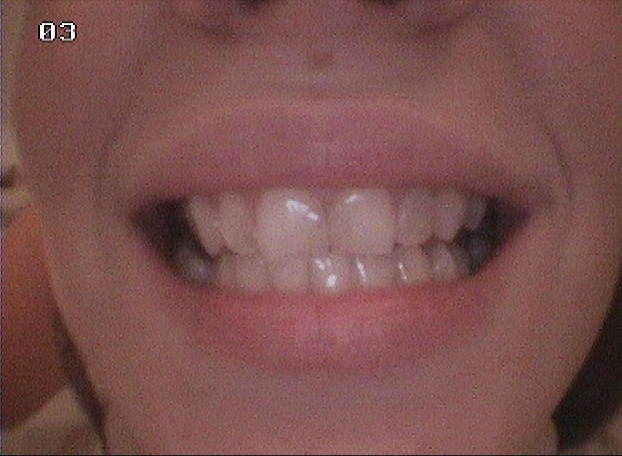

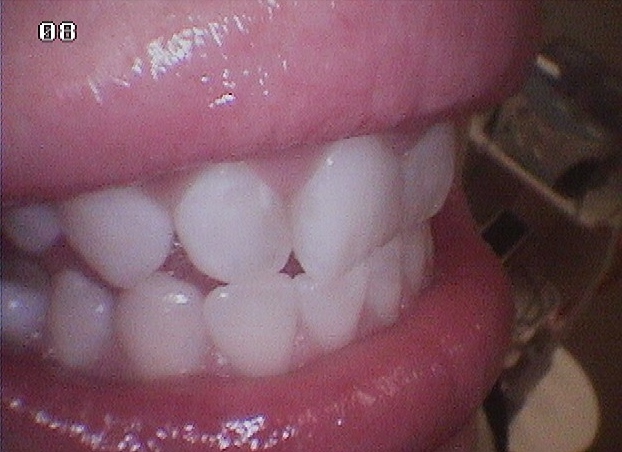


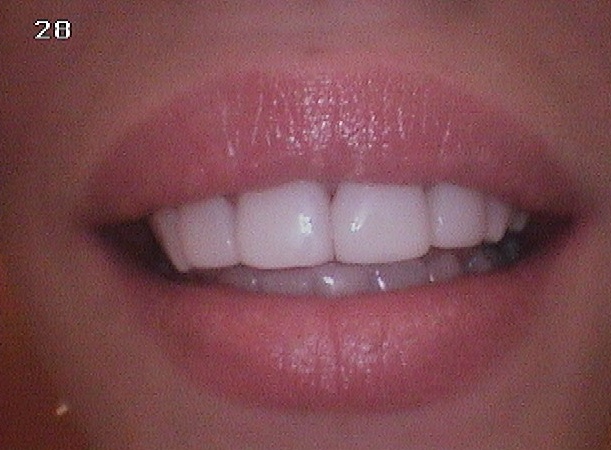

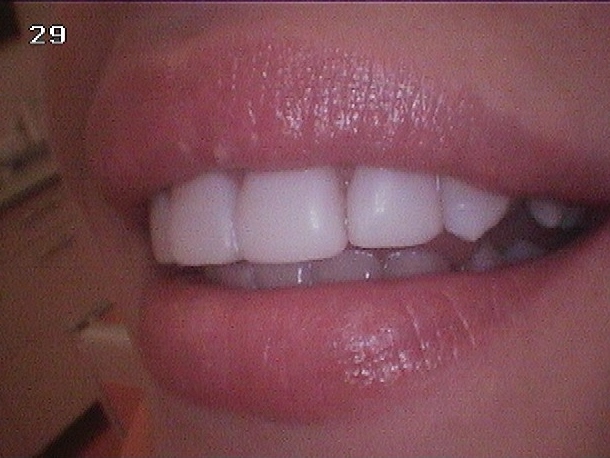
Case 2
